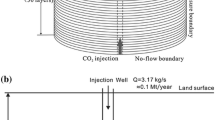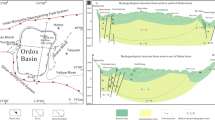Abstract
This study focused on typical injection layers of deep saline aquifers in the Shiqianfeng Formation used in the Carbon Capture and Sequestration Demonstration Projects in the Ordos Basin, Northwest China. The study employed experiments and numerical simulations to investigate the mechanism of CO2 mineral sequestration in these deep saline aquifers. The experimental results showed that the dissolved minerals are plagioclase, hematite, illite–smectite mixed layer clay and illite, whereas the precipitated minerals are quartz (at 55, and 70 °C) and kaolinite (at 70 °C). There are rare carbonate mineral precipitations at the experimental time scale, while the precipitation of quartz as a product of the dissolution of silicate minerals and some intermediate minerals rich in K and Mg that transform to clay minerals, reveals the possibility of carbonate precipitation at the longer time scale. These results are consistent with some results previously reported in the literature. We calibrated the kinetic parameters of mineral dissolution and precipitation by these experimental results and then simulated the CO2 mineral sequestration under deep saline aquifer conditions. The simulation results showed that the dissolved minerals are albite, anorthite and minor hematite, whereas the precipitated minerals are calcite, kaolinite and smectite at 55 and 70 °C. The geochemical reaction of illite is more complex. At 55 °C, illite is dissolved at the relatively lag time and transformed to dawsonite; at 70 °C, illite is precipitated in the early reaction period and then transformed to kaolinite. Based on this research, sequestrated CO2 minerals, which are mainly related to the temperature of deep saline aquifers in Shiqianfeng Fm., are calcite and dawsonite at lower temperature, and calcite at higher temperature. The simulation results also establish that calcite could precipitate over a time scale of thousands of years, and the higher the temperature the sooner such a process would occur due to increased reaction rates. These characteristics are conducive, not only to the earlier occurrence of mineral sequestration, but also increase the sequestration capacity of the same mineral components. For a sequestration period of 10,000 years, we determined that the mineral sequestration capacity is 0.786 kg/m3 at 55 °C, and 2.180 kg/m3 at 70 °C. Furthermore, the occurrence of mineral sequestration indirectly increases the solubility of CO2 in the early reaction period, but this decreases with the increase in temperature.









Similar content being viewed by others
References
Apps JA, Zheng LG, Zhang Y, Xu T, Birkholzer JT (2010) Evaluation of potential changes in groundwater quality in response to CO2 leakage from deep geological storage. Transp Porous Media 82:215–246
Aradottir ESP, Sonnenthal EL, Bjornsson G, Jonsson H (2012a) Multidimensional reactive transport modeling of CO2 mineral sequestration in basalts at the Hellisheidi geothermal field, Iceland. Int J Greenh Gas Control 9:24–40
Aradottir ESP, Sonnenthal EL, Jonsson H (2012b) Development and evaluation of a thermodynamic dataset for phases of interest in CO2 sequestration in basaltic rocks. Chem Geol 304:26–38
Assima GP, Larachi F, Molson J, Beaudoin G (2014) Impact of temperature and oxygen availability on the dynamics of ambient CO2 mineral sequestration by nickel mining residues. Chem Eng J 240:394–403
Bao WJ, Li HQ, Zhang Y (2014) Experimental investigation of enhanced carbonation by solvent extraction for indirect CO2 mineral sequestration. Greenh Gas Sci Technol 4(6):785–799
Charan SN, Prasad PSR, Sarna DS (2009) Mineral trapping in Deccan Province India: implications for geological sequestration of CO2. Geochim Cosmochim Acta 73(13):A209
Dawson GKW, Pearce JK, Biddle D, Golding SD (2015) Experimental mineral dissolution in Berea sandstone reacted with CO2 or SO2–CO2 in NaCl brine under CO2 sequestration conditions. Chem Geol 399:87–97
Du SH, Zheng LG, Zhang WJ (2015) Assessment of shallow aquifer remediation capacity under different groundwater management conditions in CGS field. Arab J Geosci 9:448
Du SH, Su XS, Xu W (2016) Assessment of CO2 geological storage capacity in oilfields of Songliao Basin, northeastern China. Geos J 20:247–257
Edlmann K, Niemi A, Bensabat J, Haszeldine RS, McDermott CI (2016) Mineralogical properties of the caprock and reservoir sandstone of the Heletz field scale experimental CO2 injection site, Israel; and their initial sensitivity to CO2 injection. Greenh Gas Sci Technol 48:94–104
Giammar DE, Bruant RG, Peters CA (2005) Forsterite dissolution and magnesite precipitation at conditions relevant for deep saline aquifer storage and sequestration of carbon dioxide. Chem Geol 217:257–276
Guo JQ, Wen DG, Zhang SQ, Xu TF, Li XF, Diao YJ, Jia XF (2015) Potential and suitability evaluation of CO2 geological storage in major sedimentary basin of China, and the demonstration project in Ordos Basin. Acta Geol Sinica 89(4):1319–1332
Han DR, Namkung H, Lee HM, Huh DG, Kim HT (2015) CO2 sequestration by aqueous mineral carbonation of limestone in a supercritical reactor. J Ind Eng Chem 21:792–796
IPCC (2005) Carbon Dioxide Capture and Storage. Cambridge University Press, Cambridge, p 431
Jarvis K, Carpenter RW, Windman T, Kim Y, Nunez R, Alawneh F (2009) Reaction mechanisms for enhanced mineral sequestration of CO2. Environ Sci Technol 43(16):6314–6319
Lammers K, Murphy R, Riendeau A, Smimov A, Schoonen MA, Strongin DR (2011) CO2 sequestration through mineral carbonation of iron oxyhydroxides. Environ Sci Technol 45(24):10422–10428
Li Q, Fei WB, Liu XH, Wei XC, Jin M, Li XC (2014) Challenging combination of CO2 geological storage and coal mining in the Ordos Basin, China. Greenh Gas Sci Technol 4(4):452–467
Liu Q, Maroto-Valer MM (2011) Parameters affecting mineral trapping of CO2 sequestration in brines. Greenh Gas Sci Technol 1(3):211–222
Liu N, Liu L, Qu XY, Yang HD, Wang LJ, Zhao S (2011) Genesis of authigene carbonate minerals in the Upper Cretaceous reservoir, Honggang Anticline, Songliao Basin: a natural analog for mineral trapping of natural CO2 storage. Sediment Geol 237(3):166–178
Liu F, Song XF, Yang LH, Han DM, Zhang YH, Ma Y, Bu HM (2015) The role of anthropogenic and natural factors in shaping the geochemical evolution of groundwater in the Subei Lake basin, Ordos energy base, Northwestern China. Sci Total Environ 538:327–340
Lu HY, Lin CK, Lin W, Liou TS, Chen WF, Chang PY (2011) A natural analogue for CO2 mineral sequestration in Miocene basalt in the Kuanhsi–Chutung area, northwestern Taiwan. Int J Greenh Gas Control 5(5):1329–1338
Lu P, Fu Q, Seyfried WE, Hedges SW, Soong Y, Jones K, Zhu C (2013) Coupled alkali feldspar dissolution and secondary mineral precipitation in batch systems-2: new experiments with supercritical CO2 and implications for carbon sequestration. Appl Geochem 30:75–90
Olajire AA (2013) A review of mineral carbonation technology in sequestration of CO2. J Petrol Sci Eng 109:364–392
Rosenbauer RJ, Koksalan T, Palandri JL (2005) Experimental investigation of CO2-brine-rock interactions at elevated temperature and pressure: implications for CO2 sequestration in deep-saline aquifers. Fuel Process Technol 86(14):1581–1597
Shao HB, Ray JR, Jun YS (2010) Dissolution and precipitation of clay minerals under geologic CO2 sequestration conditions: cO2-brine-phlogopite interactions. Environ Sci Technol 44(15):5999–6005
Smyth RC, Hovorka SD, Lu J, Romanak KD, Partin JW, Wong C, Yang CB (2009) Assessing risk to fresh water resources from long-term CO2 injection: laboratory and field studies. Energ Proced 1(1):1957–1964
Su XS, Xu W, Du SH (2013) Basin-scale storage capacity assessment of deep saline aquifers in the Songliao Basin, northeastern China. Greenh Gas Sci Technol 3:266–280
Tutolo BM, Luhmann AJ, Kong XZ, Saar MO, Seyfried WE (2015) CO2 sequestration in feldspar-rich sandstone: coupled evolution of fluid chemistry, mineral reaction rates, and hydrogeochemical properties. Geochim Cosmochim Acta 160:132–154
Ukwattage NL, Ranjith PG, Yellishetty M, Bui HH, Xu TF (2015) A laboratory-scale study of the aqueous mineral carbonation of coal fly ash for CO2 sequestration. J Clean Prod 103:665–674
Wigand M, Carey JW, Schütt H, Spangenberg E, Erzinger J (2008) Geochemical effects of CO2 sequestration in sandstones under simulated in situ conditions of deep saline aquifers. Appl Geochem 23(9):2735–2745
Wolery TJ (1992) EQ3/6, A software package for geochemical modeling of aqueous systems: Package overview and installation guide (version 7.0). Lawrence Livemore National Laboratory, Livemore
Wolff-Boenisch D, Wenau S, Gislason SR, Oelkers EH (2011) Dissolution of basalts and peridotite in seawater in the presence of ligands and CO2: implications for mineral sequestration of carbon dioxide. Geochim Cosmochim Acta 75(19):5510–5525
Xie J, Zhang KN, Hu LT, Pavelic P, Wang YS, Chen MS (2015a) Field-based simulation of a demonstration site for carbon dioxide sequestration in low-permeability saline aquifers in the Ordos basin, China. Hydrogeol J 23(7):1465–1480
Xie J, Zhang KN, Hu LT, Wang YS, Chen MS (2015b) Understanding the carbon dioxide sequestration in low-permeability saline aquifers in the Ordos Basin with numerical simulations. Greenh Gas Sci Technol 5(5):558–576
Xu TF, Apps JA, Pruess K (2003) Reactive geochemical transport simulation to study mineral trapping for CO2 disposal in deep arenaceous formations. J Geophys Res Solid Earth 108(B2):345–368
Xu TF, Apps JA, Pruess K (2004a) Numerical simulation of CO2 disposal by mineral trapping in deep aquifers. Appl Geochem 19(6):917–936
Xu TF, Sonnenthal E, Spycher N, Pruess K (2004b) TOUGHREACT user’s guide: a simulation program for non-isothermal multiphase reactive geochemical transport in variably saturated geologic media. Lawrence Berkeley National Laboratory Report LBNL-55460. 195
Xu TF, Apps JA, Pruess K, Yamamoto H (2007) Numerical modeling of injection and mineral trapping of CO2 with H2S and SO2 in a sandstone formation. Chem Geol 242(3–4):319–346
Xu TF, Spycher N, Sonnenthal E, Zhang GX, Zheng LG, Pruess K (2011) TOUGHREACT Version 2.0: a simulator for subsurface reactive transport under non-isothermal multiphase flow conditions. Comput Geosci 37(6):763–774
Zevenhoven R, Fagerlund J, Songok JK (2011) CO2 mineral sequestration: developments toward large-scale application. Greenh Gas Sci Technol 1(1):48–57
Zhao RR, Cheng JM, Zhang K, Liu N, Xu FQ (2015) Numerical investigation of basin-scale storage of CO2 in saline aquifers of Songliao Basin, China. Greenh Gas Sci Technol. 5:180–197
Zheng LG, Apps JA, Zhang YQ, Xu TF, Birkholzer JT (2009) On mobilization of lead and arsenic in groundwater in response to CO2 leakage from deep geological storage. Chem Geol 268(3–4):281–297
Zheng LG, Apps JA, Spycher N, Birkholzer JT, Kharaka YK, ThordsenJ Beers SR, Herkelrath WN, Kakouros E, Trautz RC (2012) Geochemical modeling of changes in shallow groundwater chemistry observed during the MSU-ZERT CO2 injection experiment. Int J Greenh Gas Control 7:202–217
Acknowledgements
This work was supported by China Geological Survey (No. [2014] 02-022-015-W01), the Jilin Province Science and Technology Development Plan (No. 20140520143JH) and the Multi-Subjects Research Program for Ph.D. student in Jilin University (No. 2011J012). We also thank Dr Xiaosi Su for his helps in the experiments processes.
Author information
Authors and Affiliations
Corresponding author
Rights and permissions
About this article
Cite this article
Wan, Y., Du, S., Lin, G. et al. Experimental and numerical simulation study of the mineral sequestration mechanism of the Shiqianfeng saline aquifers in the Ordos Basin, Northwest China. Environ Earth Sci 76, 43 (2017). https://doi.org/10.1007/s12665-016-6371-1
Received:
Accepted:
Published:
DOI: https://doi.org/10.1007/s12665-016-6371-1




